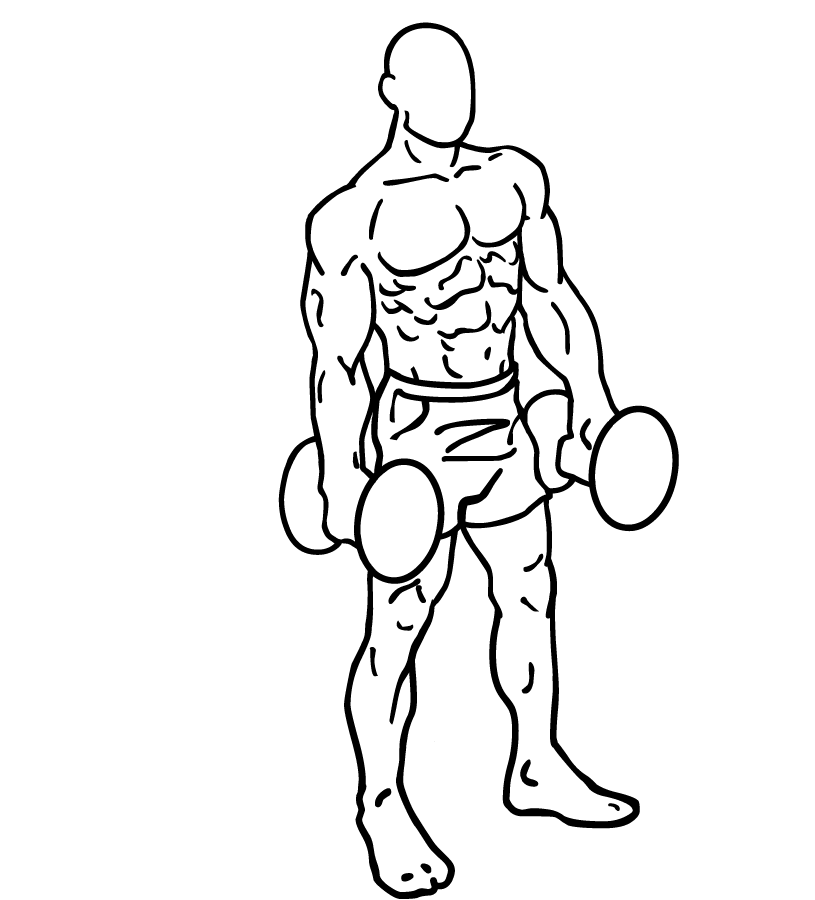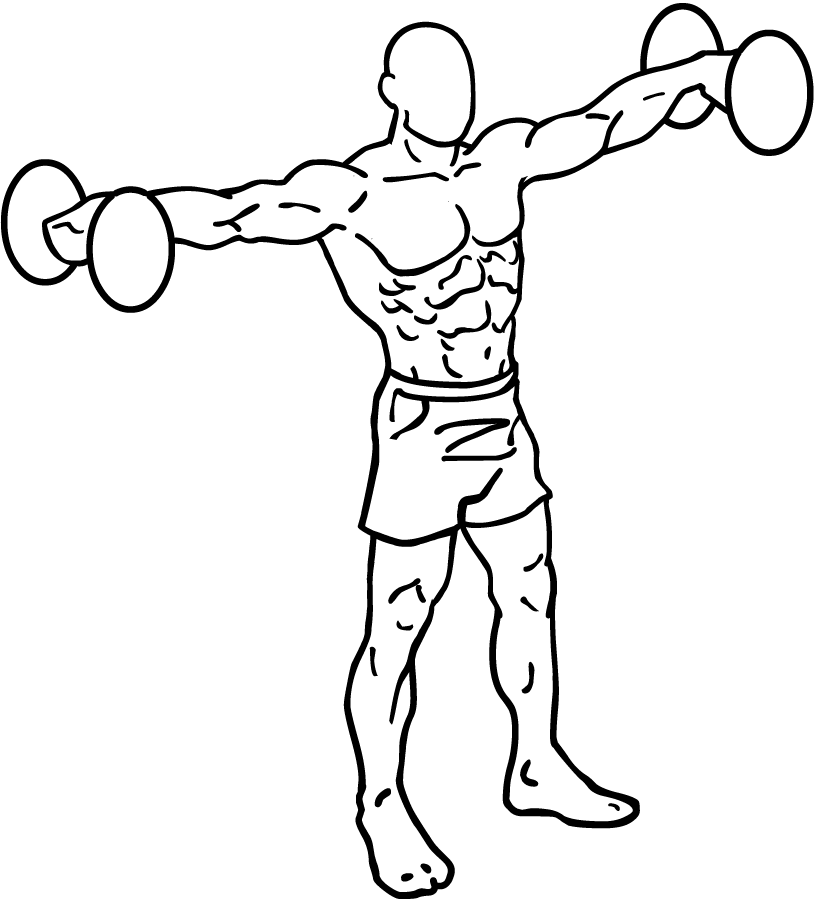Last Updated on September 26, 2014
Lateral dumbbell raises are a staple in upper body workouts, particularly for those looking to develop strong, sculpted shoulders. This exercise specifically targets the lateral deltoid, helping to create width and shape in the shoulder muscles. Along with strengthening the shoulders, lateral raises engage the forearms and upper back, making it a comprehensive movement for building upper body strength and stability. In this guide, we’ll explore the technique, benefits, variations, and common mistakes to avoid when performing lateral dumbbell raises.
What are Lateral Dumbbell Raises?
Lateral dumbbell raises involve lifting a pair of dumbbells out to the sides of your body, targeting the lateral deltoid (the middle part of the shoulder). This isolation exercise is effective for developing shoulder width and enhancing the visual appearance of the upper body. While simple in execution, proper form is crucial to maximize its benefits and avoid injury. By using this exercise into your routine, you can improve shoulder strength, stability, and definition.
Muscles Worked During Lateral Dumbbell Raises
The primary muscles activated include:
- Lateral Deltoid: The lateral (or middle) head of the deltoid is the main focus, responsible for shoulder abduction, which is the movement of lifting the arms away from the body.
- Trapezius: The upper back muscles (traps) are also engaged, providing support and stability during the lift.
- Forearms: Holding and controlling the dumbbells engages the forearms, helping to improve grip strength and forearm endurance.
Secondary muscles involved:
- Anterior Deltoid: The front part of the shoulder assists in stabilizing the arm during the raise.
- Core Muscles: Maintaining a stable posture throughout the exercise requires core engagement to support the spine and prevent arching.
How to Perform Lateral Dumbbell Raises: Step-by-Step Guide
To perform lateral dumbbell raises effectively and safely, follow these steps:
- Set Up Your Position:
- Stand with your feet shoulder-width apart. Hold a dumbbell in each hand, with your palms facing inward towards your body. Let the dumbbells rest at your sides.
- Engage your core by drawing your abs in and keep a slight bend in your knees to stabilize your stance.
- Maintain Proper Posture:
- Keep your back straight and your chest lifted. Avoid arching your lower back, which can put unnecessary strain on your spine.
- Keep your head in a neutral position, looking straight ahead.
- Execute the Movement:
- While keeping your torso still, raise your arms out to the sides. Your arms should remain straight but with a slight bend in the elbows to reduce strain on the joints.
- Lift the dumbbells until your arms are parallel to the floor, in line with your shoulders. Your palms should face downward at the top of the movement.
- Pause and Lower:
- Hold the top position for a moment, feeling the contraction in your lateral deltoids.
- Slowly lower the dumbbells back to the starting position in a controlled manner. Avoid letting the weights drop quickly, as this reduces muscle engagement and increases the risk of injury.
- Repeat for Desired Repetitions:
- Aim for 10-15 repetitions per set, focusing on maintaining good form throughout each repetition.
Tips for Proper Form
To get the most out of lateral dumbbell raises and minimize the risk of injury, keep these essential tips in mind:
- Maintain a Neutral Spine: Avoid arching your lower back. Engage your core muscles to keep your spine neutral and protect it from strain.
- Avoid Using Momentum: Keep the movement slow and controlled, focusing on lifting the dumbbells with your shoulder muscles rather than swinging your arms.
- Keep Elbows Slightly Bent: A slight bend in the elbows reduces the risk of hyperextension and allows for a more comfortable movement.
- Breathe Properly: Inhale as you prepare for the lift, and exhale as you raise the dumbbells. Controlled breathing helps stabilize your core and maintain focus.
Benefits of Lateral Dumbbell Raises
- Builds Shoulder Width and Shape: By targeting the lateral deltoid, this exercise helps develop broader shoulders, contributing to a more balanced and aesthetic upper body physique.
- Improves Upper Body Strength: Regularly performing lateral raises increases strength in the shoulders and upper back, enhancing overall upper body stability and function.
- Enhances Shoulder Mobility and Stability: The movement pattern of lifting the arms helps improve shoulder joint mobility and stability, which is important for preventing injuries, especially in sports or activities that require overhead motions.
- Strengthens the Core: Although the focus is on the shoulders, maintaining posture during the exercise activates the core muscles, improving overall stability and functional strength.
- Versatile and Accessible: Lateral dumbbell raises require minimal equipment and can be performed almost anywhere. They are suitable for all fitness levels, making them a versatile addition to any strength training routine.
Variations of Lateral Dumbbell Raises
To keep your workouts dynamic and challenge your muscles differently, try incorporating these variations:
1. Single-Arm Lateral Raise
This variation focuses on one arm at a time, allowing for greater concentration on each shoulder. It also helps correct muscle imbalances and engages the core more intensely as you work to stabilize your body.
- How to Perform: Stand as you would for the standard lateral raise, but only lift one arm at a time. Perform all reps on one side before switching to the other arm.
2. Seated Lateral Raise
Performing the exercise while seated removes the ability to use momentum, further isolating the shoulder muscles and increasing the challenge.
- How to Perform: Sit on a bench with your feet flat on the floor. Hold the dumbbells at your sides and perform the raise without using your legs or torso to assist.
3. Cable Lateral Raise
Using a cable machine provides consistent tension throughout the movement, enhancing muscle activation.
- How to Perform: Stand next to a cable machine with the cable set to the lowest position. Hold the handle with the arm farthest from the machine and lift your arm out to the side. This variation keeps constant resistance, maximizing muscle engagement.
4. Incline Lateral Raise
This advanced variation targets the lateral deltoid from a different angle, adding variety to your shoulder workout.
- How to Perform: Lie on your side on an incline bench, holding a dumbbell in the top hand. Lift the dumbbell in a lateral raise motion, isolating the shoulder muscles in a unique position.
Common Mistakes to Avoid
Lateral dumbbell raises may seem straightforward, but improper form can reduce their effectiveness and lead to injury. Here are some common mistakes and how to avoid them:
- Lifting Too Heavy: Using a weight that is too heavy often leads to swinging the body or arching the back. Start with lighter weights to focus on form and gradually increase the load as you become stronger.
- Raising the Arms Too High: Lifting the dumbbells above shoulder height can put unnecessary stress on the shoulder joints. Aim to raise your arms until they are in line with your shoulders for optimal muscle engagement.
- Flaring the Elbows: Keeping the elbows locked or flared out too much can strain the shoulder joints. Maintain a slight bend in your elbows and lift with control.
- Using Momentum: Swinging the weights or using momentum takes the focus away from the deltoids and increases the risk of injury. Focus on slow, controlled movements to engage the target muscles effectively.
- Neglecting Posture: Letting your chest drop or arching your back can strain your lower back. Engage your core, keep your back straight, and maintain an upright posture.
Programming Lateral Dumbbell Raises into Your Routine
To maximize the benefits of lateral raises, integrate them into your workout program strategically:
- Shoulder Day Routine: Include 3-4 sets of 10-15 repetitions in your shoulder or upper body workout routine to target the deltoids directly.
- Full-Body Circuit: Incorporate lateral raises into a full-body workout circuit alongside exercises like squats, push-ups, and bicep curls for balanced development.
- Warm-Up or Activation Exercise: Use light weights to perform lateral raises as part of your warm-up, activating the shoulders before heavy lifting or upper body workouts.
FAQs About Lateral Dumbbell Raises
Q1: Can beginners perform lateral dumbbell raises?
Yes, lateral dumbbell raises are suitable for beginners, but it’s crucial to start with light weights to learn the correct form and technique. Focusing on form before increasing weight helps prevent injury and maximizes muscle development.
Q2: How often should I do lateral dumbbell raises?
For balanced shoulder development, perform lateral dumbbell raises 2-3 times a week as part of your upper body or shoulder workout routine. Allow at least one day of rest between sessions to ensure muscle recovery.
Q3: Should I use heavy weights for lateral raises?
No, lateral raises are best performed with lighter weights. This allows you to maintain proper form and control, which is essential for effectively targeting the lateral deltoids. Over time, you can gradually increase the weight as your strength and form improve.
Conclusion
Lateral dumbbell raises are an essential exercise for developing strong, sculpted shoulders. By focusing on proper form, controlled movements, and gradually increasing resistance, you can effectively target and build the lateral deltoid muscles. Whether you’re aiming for a balanced upper body, increased shoulder strength, or improved shoulder definition, lateral dumbbell raises provide the targeted engagement needed to achieve these goals. Incorporating them consistently into your routine will not only enhance your shoulder aesthetics but also contribute to overall upper body stability and strength.
Final Tips for Success with Lateral Dumbbell Raises
To ensure you get the most out of this exercise:
- Start Light and Focus on Form: Master the technique with light weights before progressing. Proper form is more important than lifting heavy, as it ensures that the lateral deltoids are fully engaged.
- Use a Mirror: Performing the exercise in front of a mirror can help you monitor your posture and arm movement, ensuring your form remains correct.
- Combine with Other Shoulder Exercises: To achieve balanced shoulder development, combine lateral raises with other shoulder exercises like overhead presses, front raises, and rear delt flys. This helps engage all three heads of the deltoid for complete shoulder development.
- Warm Up Before Lifting: Preparing your shoulders with mobility exercises and light stretching before performing lateral raises can help prevent injuries and ensure that your muscles are ready for the movement.
Lateral dumbbell raises are a simple yet powerful exercise that, when performed correctly, can significantly enhance shoulder strength, mobility, and aesthetics. Whether you’re a beginner building foundational strength or an experienced lifter refining muscle detail, this exercise is a valuable addition to your training regimen. Remember, the key to success with lateral dumbbell raises lies in maintaining proper form, focusing on the lateral deltoid, and progressing gradually.
Incorporate lateral raises into your routine, and over time, you’ll see noticeable improvements in shoulder width, strength, and definition.








